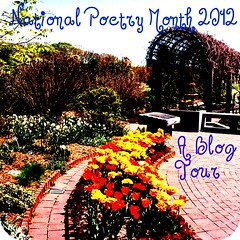
Not only will you be part of a tour involving poetry collections, poet interviews, guest posts from poetry readers, and maybe even just some great poems and discussion, you also get my new snazzy button — and I can’t believe I made it myself from a photo my hubby took at the National Arboretum. OK, that’s a lame reason to join the blog tour.
I’m hoping to put together some great giveaways for everyone who participates either as a commenter or as a blog tour host/guest blogger.
I hope that even if you don’t want to participate you’ll spread the word. I want to fill up every day in April. Dates will be a first come, first serve basis, and I’ll be posting the participating blogs on the schedule below as I hear from people.
Won’t you join me in celebrating poetry?
Sunday, April 1 — Savvy Verse & Wit’s Kickoff of the blog tour
Monday, April 2 — Sara from Wordy Evidence of the Fact
Tuesday, April 3 — Jill from Rhapsody in Books will talk about Cole Porter
Wednesday, April 4 — Anna from Diary of an Eccentric, WWI Poetry Anthology
Thursday, April 5 — Audra from Unabridged Chick
Friday, April 6 — Michael Meyerhofer from Trouble With Hammers
and My Friend Amy hosts Sweta Vikram’s Guest Post
Saturday, April 7 — Dar from Peeking Between the Pages
Sunday, April 8 — Patty from Books, Thoughts and A Few Adventures…
Monday, April 9 — Naida from the Bookworm
Tuesday, April 10 — Kathy from Bermudaonion, tentatively THE WATCH THAT ENDS THE NIGHT by Allan Wolf
Wednesday, April 11 — Jeanne from Necromancy Never Pays, who will discuss litany poems and then show and discuss Richard Siken’s “Litany in Which Certain Things Are Crossed Out”
Thursday, April 12 — Julie from Read Handed will talk about 2010 Cider Press Book Award winning collection Play Button by Liz Robbins
Friday, April 13 — Melanie from The Indextrious Reader on superstitions and poetry
Saturday, April 14 — Cecelia from Adventures of Cecelia Bedelia
Sunday, April 15 — Ana from Things Mean a Lot
Monday, April 16 — Cassandra from Indie Reader Houston
Tuesday, April 17 — Ti from Book Chatter
Wednesday, April 18 — The Girl from Diary of an Eccentric will focus on Robert Frost
Thursday, April 19 — Pam from Bookalicious
Friday, April 20 — Tabatha of Tabatha Yeatts: The Opposite of Indifference
Saturday, April 21 — Megan from Solid Quarter
Sunday, April 22 — Nicole Luongo from Bare Your Naked Truth at Peeking Between the Pages.
Monday, April 23 — Adrienne Odasso from Seer of Ghosts and Weaver of Stories
Tuesday, April 24 — Arisa White from Arisa White
Wednesday, April 25 — Craig from Mr. Watson
Thursday, April 26 — Wallace from Unputdownables will focus on Edna St. Vincent Millay and Dorothy Parker
Friday, April 27 — Wendy from Caribousmom will host Poet Michael Meyerhofer and his guest post on self-publishing
Saturday, April 28 — David from Wordcoaster who will showcase bird poetry.
Sunday, April 29 — Sidne from Sidne, The Reading Socialite who will discuss Love and/or Life
Monday, April 30 — Travis Laurence Naught on how Jack Kerouac and Jim Morrison (maybe even Allen Ginsberg) formed his writing style
Thanks, everyone.
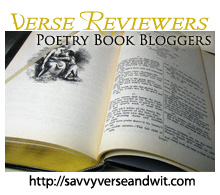
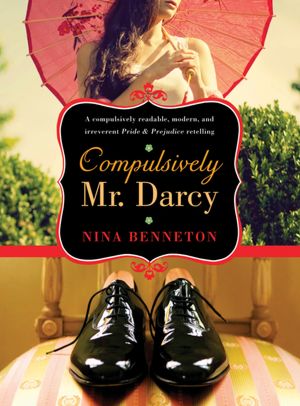
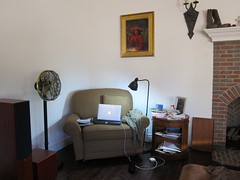 I call this Jane Austen writing space. The family refers to this as Mama’s throne, my Jane Austen writing space in one corner of the family room. On that round table there, I keep whatever reference books I need for the novel I’m working on (three novels concurrently). Six feet to the left of my chair, a piano sits, convenient for me to Tiger-mother-supervise daily piano practice while I’m writing. To the right of my chair is a large, flat-screen TV that’s rarely on, thank goodness. Diagonal from my chair is a large sectional couch where my husband sits and practices his guitar, and where my kids read or play games (and make too much noise). My favorite and best writing time is in the morning, when I wake up at 3:30 AM to get some writing done right in this chair, and the room is quiet and empty. I get the majority of my fresh writing done until 6:00 AM, when the family wakes up. On the weekends, it’s golden because they don’t get up until 9AM or later and I can actually get 6 hours in. I go to bed two hours after the children do, at 10:00PM (after I sneak in some editing or working on writing classes’ assignments).
I call this Jane Austen writing space. The family refers to this as Mama’s throne, my Jane Austen writing space in one corner of the family room. On that round table there, I keep whatever reference books I need for the novel I’m working on (three novels concurrently). Six feet to the left of my chair, a piano sits, convenient for me to Tiger-mother-supervise daily piano practice while I’m writing. To the right of my chair is a large, flat-screen TV that’s rarely on, thank goodness. Diagonal from my chair is a large sectional couch where my husband sits and practices his guitar, and where my kids read or play games (and make too much noise). My favorite and best writing time is in the morning, when I wake up at 3:30 AM to get some writing done right in this chair, and the room is quiet and empty. I get the majority of my fresh writing done until 6:00 AM, when the family wakes up. On the weekends, it’s golden because they don’t get up until 9AM or later and I can actually get 6 hours in. I go to bed two hours after the children do, at 10:00PM (after I sneak in some editing or working on writing classes’ assignments). I call this my Virginia Woolf space. My writing office is off the master bedroom, on the other side of the house, away from the family room. Because I don’t want to isolate myself physically from my family, I’m rarely in here. When I need absolute silence to concentrate, I come here. My family is very good about respecting my time in here and only bother me if they absolutely cannot find the milk on the fridge shelf right in front of their noses, or if they can’t tell if the dishwasher is dirty or clean, or if someone is calling someone a naughty name.
I call this my Virginia Woolf space. My writing office is off the master bedroom, on the other side of the house, away from the family room. Because I don’t want to isolate myself physically from my family, I’m rarely in here. When I need absolute silence to concentrate, I come here. My family is very good about respecting my time in here and only bother me if they absolutely cannot find the milk on the fridge shelf right in front of their noses, or if they can’t tell if the dishwasher is dirty or clean, or if someone is calling someone a naughty name. I call this writing space my Blue Highways space (since William Least Heat-Moon space is too much of a mouthful). I have my daughter’s old pink Princess laptop pillow in the backseat of the van. (Not enough space for my laptop behind the steering wheel). When my kids are at ballet or soccer or swimming practice, I’m in the backseat of the van in the parking lot working on my writing. I go to performances and games, but during practice times, even if it’s only fifteen or twenty minutes in the parking lot, I steal for my writing.
I call this writing space my Blue Highways space (since William Least Heat-Moon space is too much of a mouthful). I have my daughter’s old pink Princess laptop pillow in the backseat of the van. (Not enough space for my laptop behind the steering wheel). When my kids are at ballet or soccer or swimming practice, I’m in the backseat of the van in the parking lot working on my writing. I go to performances and games, but during practice times, even if it’s only fifteen or twenty minutes in the parking lot, I steal for my writing.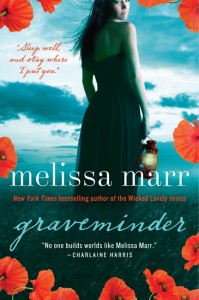
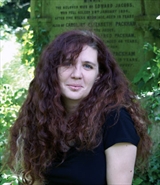 About the Author:
About the Author:









